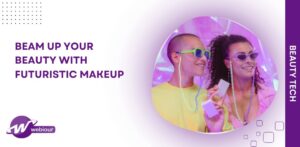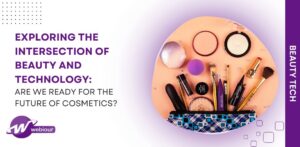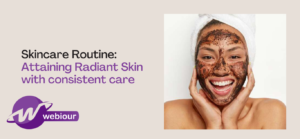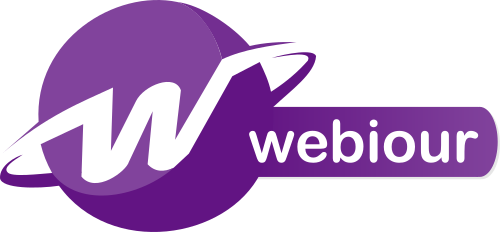In recent years, we’ve seen a rapid expansion of technology in the beauty industry. From virtual makeup try-on tools to smart mirrors that offer personalized skincare recommendations, it’s clear that beauty and technology are increasingly intersecting. But what does this mean for the future of cosmetics?
On one hand, technology has the potential to revolutionize the way we approach beauty and self-care. Wearable devices can help us track our skincare routines, DNA-based recommendations can offer personalized skincare regimens, and virtual try-on tools allow us to experiment with different makeup looks without committing to a purchase.
On the other hand, there are also challenges and ethical considerations to consider when it comes to the intersection of beauty and technology. Personal data collection, the perpetuation of harmful beauty standards, and the need for inclusivity and diversity in development are all important factors to consider as technology continues to shape the beauty industry.
In this blog post, we’ll delve into the current applications of beauty technology, the challenges and ethical considerations it presents, and predictions for how technology will continue to impact the beauty industry in the future. By understanding both the potential and the potential pitfalls of beauty technology, we can approach it with caution and consideration for its impacts on ourselves and our society.
Current Applications of Beauty Technology
In recent years, there has been a surge in the development and adoption of beauty technology. From skincare to makeup application, technology is playing a larger role in the way we approach beauty and self-care. Here are a few examples of current applications of beauty technology:
Wearable Devices for Skincare and Makeup Application: There are now a variety of wearable devices on the market that are designed to help us track and improve our skincare routines. For example, the Neutrogena Skin360 device is a small sensor that can be attached to your phone’s camera to scan your skin and provide personalized skincare recommendations. There are also wearable devices like the L’Oreal UV Sense and the La Roche-Posay My Skin Track UV that can help us track our sun exposure and protect our skin from UV damage.
Virtual Makeup Try-On Tools: Many makeup brands now offer virtual try-on tools that allow users to experiment with different makeup looks without committing to a purchase. These tools use augmented reality technology to show users what a particular shade or product will look like on their own face. Brands like Sephora, CoverGirl, and L’Oreal Paris all offer virtual try-on tools on their websites.
Smart Mirrors and Augmented Reality Beauty Experiences: Smart mirrors are another example of technology being integrated into the beauty industry. These mirrors use augmented reality to provide users with personalized skincare recommendations and makeup application tips. For example, the HiMirror Plus smart mirror can analyze your skin and provide customized skincare recommendations based on your specific skin concerns.
DNA-Based Skincare Recommendations: Another application of beauty technology is the use of DNA testing to provide personalized skincare recommendations. Companies like Dermalogica and Geneu offer DNA testing kits that analyze your genetics to provide customized skincare regimens based on your unique skin needs.
Overall, these are just a few examples of how technology is being integrated into the beauty industry. From wearable devices to virtual try-on tools, it’s clear that technology has the potential to enhance and personalize the beauty experience. However, as we’ll discuss in the next section, there are also important challenges and ethical considerations to consider when it comes to the intersection of beauty and technology.
Challenges and Ethical Considerations
As the beauty industry continues to embrace technology, there are a number of challenges and ethical considerations that must be taken into account. Here are a few key areas of concern:
Privacy Concerns Around Personal Data Collection: One major challenge when it comes to beauty technology is the issue of personal data collection. Many of the wearable devices and smart mirrors mentioned in the previous section rely on collecting data about our skin and beauty routines. While this data can be used to provide personalized recommendations, it also raises concerns about privacy and the potential for this data to be misused.
The Potential for Technology to Perpetuate Harmful Beauty Standards: Another challenge to consider is the potential for technology to perpetuate harmful beauty standards. For example, virtual makeup try-on tools may only offer a limited range of shades, which could exclude certain skin tones or perpetuate narrow beauty standards. Similarly, smart mirrors and other augmented reality beauty experiences may present an idealized version of beauty that is unrealistic or unhealthy to strive for.
The Need for Inclusivity and Diversity in Beauty Technology Development: Finally, it’s important to consider the need for inclusivity and diversity in the development of beauty technology. It’s crucial that these tools and devices are designed and tested with a diverse range of users in mind, rather than catering to a narrow standard of beauty.
Overall, it’s clear that while technology has the potential to enhance and personalize the beauty experience, it’s important to approach it with caution and consideration for its potential impacts. As the beauty industry continues to evolve and embrace technology, it will be crucial to address these challenges and ethical considerations in order to create responsible and inclusive innovations.
The Future of Beauty Technology
As the beauty industry continues to embrace technology, it’s natural to wonder what the future holds. Here are a few predictions for how technology will continue to shape the beauty industry:
- Increased Personalization: One trend we are likely to see in the future of beauty technology is an increase in personalization. With the advent of DNA-based skincare recommendations and other personalized approaches, we can expect to see more products and services that are tailored specifically to our individual needs and preferences.
- Wearables for Beauty and Self-Care: Another area where we are likely to see continued growth is in the realm of wearable devices for beauty and self-care. From skincare tracking to virtual reality meditation experiences, it’s likely that we’ll see a proliferation of devices that help us manage our health and well-being.
- Virtual Beauty Services: With the rise of telemedicine and other virtual services, it’s likely that we’ll also see an increase in virtual beauty services. This could include virtual consultations with dermatologists or virtual makeup artist sessions, allowing us to access beauty and skincare services from the comfort of our own homes.
- Augmented Reality Beauty Experiences: Finally, we can expect to see more augmented reality beauty experiences in the future. From virtual try-on tools to smart mirrors that offer personalized recommendations, it’s likely that we’ll see an increase in the use of AR technology in the beauty industry.
Overall, it’s clear that technology has the potential to revolutionize the way we approach beauty and self-care. However, it’s important to approach this technology with a focus on responsible innovation. By considering the challenges and ethical considerations discussed in the previous section, we can ensure that technology is used to enhance and personalize the beauty experience in a way that is inclusive and respectful of diversity.
Conclusion
As the beauty industry continues to embrace technology, it’s clear that there is both great potential and important challenges to consider. On one hand, technology has the power to enhance and personalize the beauty experience in ways that were previously unimaginable. Wearable devices can help us track our skincare routines, virtual makeup try-on tools allow us to experiment with different looks without committing to a purchase, and DNA-based skincare recommendations can provide customized regimens based on our unique skin needs.
However, it’s also important to approach beauty technology with caution and consideration for its potential impacts. Privacy concerns around personal data collection, the potential for technology to perpetuate harmful beauty standards, and the need for inclusivity and diversity in development are all important factors to consider.
As we look to the future of beauty and technology, it’s crucial that we focus on responsible innovation. By taking these challenges and ethical considerations into account, we can create tools and devices that enhance and personalize the beauty experience in a way that is respectful and inclusive. By doing so, we can ensure that technology is used to empower and support individuals as they care for their own well-being and beauty.







